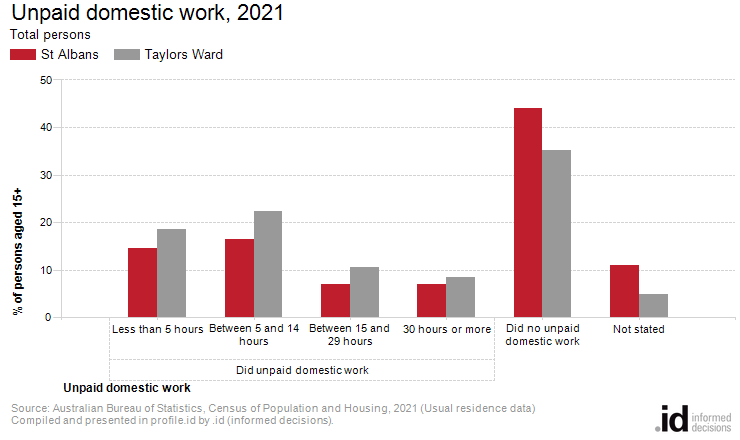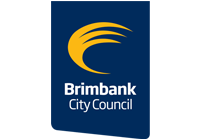St Albans
Unpaid domestic work
In St Albans 14.0% of the population over 15 did more than 14 hours of housework each week in 2021.
There has been increased interest in identifying, acknowledging and valuing the unpaid work that supports home and community life. The changing amount of time spent on unpaid housework in different Household Types and, particularly the distribution of this work within the household, can indicate the changing roles of males, females and older children in society. The level of unpaid domestic work in St Albans may also be related to Household Income, as higher income households are able to outsource some of these tasks.
Derived from the Census question:
'In the last week did the person spend time doing unpaid domestic work for their household?'
Persons aged 15 years and over.
| Unpaid domestic work | ||||||||
|---|---|---|---|---|---|---|---|---|
| St Albans - Persons aged 15+ (Usual residence) | 2021 | 2016 | Change | |||||
| Hours spent on unpaid domestic work | Number | % | Taylors Ward % | Number | % | Taylors Ward % | 2016 to 2021 | |
| Did unpaid domestic work | 14,299 | 44.9 | 60.0 | 15,929 | 51.4 | 63.2 | -1,630 | 10001 |
| Less than 5 hours | 4,655 | 14.6 | 18.6 | 5,830 | 18.8 | 22.3 | -1,175 | 10002 |
| Between 5 and 14 hours | 5,196 | 16.3 | 22.4 | 5,483 | 17.7 | 22.7 | -287 | 10003 |
| Between 15 and 29 hours | 2,248 | 7.1 | 10.4 | 2,288 | 7.4 | 9.6 | -40 | 10004 |
| 30 hours or more | 2,200 | 6.9 | 8.5 | 2,328 | 7.5 | 8.5 | -128 | 10005 |
| Did no unpaid domestic work | 14,023 | 44.1 | 35.2 | 11,507 | 37.2 | 29.7 | +2,516 | 10006 |
| Not stated | 3,503 | 11.0 | 4.8 | 3,537 | 11.4 | 7.1 | -34 | 10007 |
| Total persons aged 15+ | 31,825 | 100.0 | 100.0 | 30,973 | 100.0 | 100.0 | +852 | |
Source: Australian Bureau of Statistics, Census of Population and Housing (opens a new window) 2016 and 2021. Compiled and presented by .id (opens a new window)(informed decisions).

Compiled and presented in profile.id by .id (informed decisions).

Compiled and presented in profile.id by .id (informed decisions).
Dominant groups
Analysis of the unpaid domestic work performed by the population in St Albans in 2021 compared to Taylors Ward shows that there was a lower proportion of persons who performed 15 hours or more of unpaid domestic work per week.
Overall, 14.0% of the population reported performing 15 hours or more of unpaid domestic work, compared with 18.9% for Taylors Ward.
The major differences between the share of the population performing unpaid domestic work in St Albans and Taylors Ward were:
- A larger percentage of persons who did no unpaid domestic work (44.1% compared to 35.2%)
- A smaller percentage of persons who did unpaid domestic work (total) (44.9% compared to 60.0%)
- A smaller percentage of persons who did between 5 and 14 hours of domestic work (16.3% compared to 22.4%)
- A smaller percentage of persons who did less than 5 hours of domestic work (14.6% compared to 18.6%)
Emerging groups
The largest changes in the number of people performing unpaid domestic work in St Albans, between 2016 and 2021 were those who:
- Did no unpaid domestic work (+2,516 persons)
- Did unpaid domestic work (-1,630 persons)
- Did less than 5 hours of domestic work (-1,175 persons)
- Did between 5 and 14 hours of domestic work (-287 persons)
